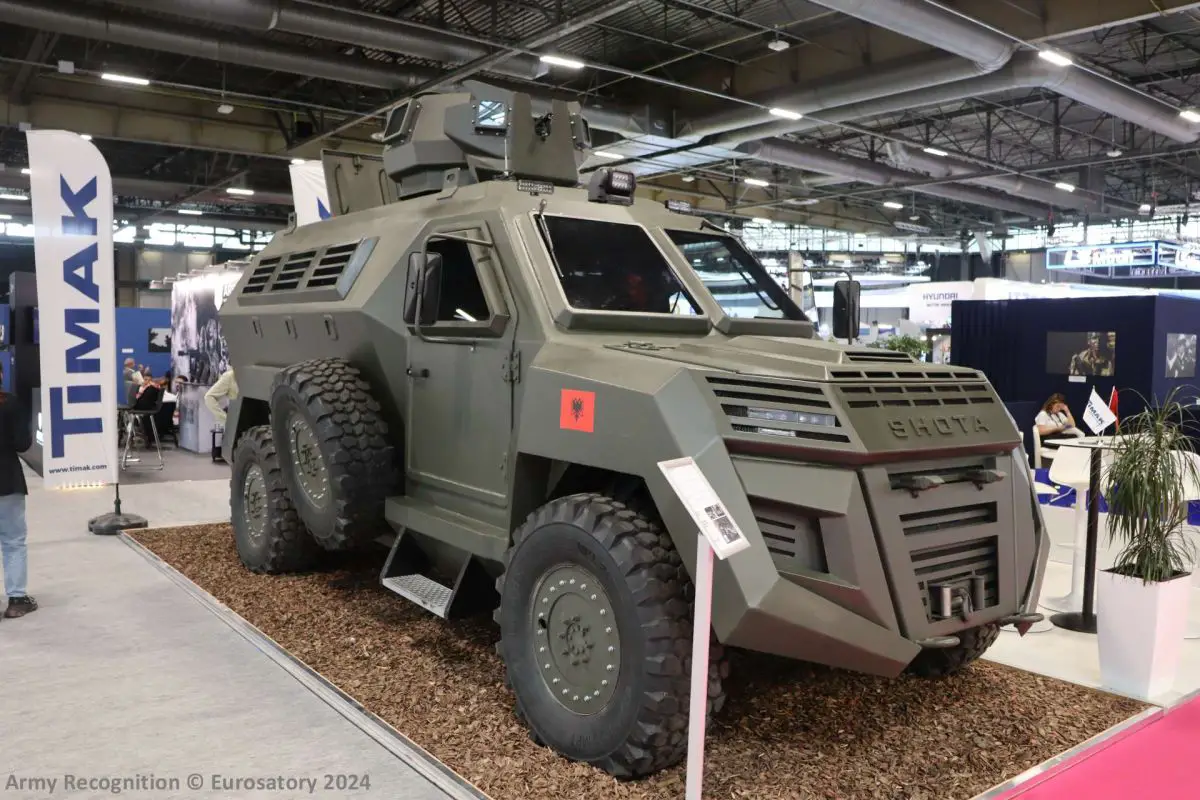Breaking News
Eurosatory 2024: Women engineers from Timak develop Albania's first MRAP vehicle named Shota.
At the Eurosatory 2024 exhibition, the Albanian company Timak displayed for the first time the Shota, the first MRAP vehicle from Albania, which was developed by women engineers. Using a Ford F-550 chassis, this vehicle features enhanced protection against threats such as ballistic arms fire, mine blasts, and improvised explosive devices (IEDs), along with a V-shaped bottom to mitigate blast impacts.
Follow Army Recognition on Google News at this link

The Shota Mine Resistant Ambush Protected (MRAP) project is supported by the Albanian Ministry of Defense, aiming to reduce Albania's reliance on foreign military equipment and foster a domestic military industry. (Picture source: Army Recognition)
Timak, which has historically produced police cars and ambulances, expanded into military vehicles due to a need for protected military ambulances, including those for Ukraine. This move is driven by changing geopolitical dynamics in Europe and the region. The Shota Mine Resistant Ambush Protected (MRAP) project is supported by the Albanian Ministry of Defense, aiming to reduce Albania's reliance on foreign military equipment and foster a domestic military industry.
The Shota MRAP features Armox Advanced 9mm armor with a BR7 protection level, offering resistance to 7.62×39mm API BZ rounds at 30 meters with a velocity of 695 meters per second. The vehicle also includes 56-millimeter-thick ballistic glass and can be equipped with additional armor. It utilizes a V-shaped bottom to mitigate shock waves from blasts and incorporates advanced materials for ballistic protection.
Inside, the vehicle is equipped with seats featuring four-point safety harnesses with quick-release mechanisms, complying with automotive legislation, including seat belt anchorage test 76/115/EEC M2. The driver and commander seats have floor-mounted blast mitigation units, height adjustments of 60 millimeters, slide-rail adjustments of 160 millimeters, head-rest and head lateral support, and back angle adjustment. Crew seats are also equipped with blast mitigation, body and head lateral support, and head rests.
Externally, the Shota MRAP includes heavy-duty vehicular handles, reinforced door hinges, stand-on running boards and fenders, and front and rear bumpers designed to withstand ramming obstacles. It has a 13-ton towing hook and heavy-duty run-flats on all tires. The vehicle measures 6.5 meters in length, 2.68 meters in width, and 2.1 meters in height, with a weight of 8 tons. It accommodates a crew of 2 plus 8 additional personnel and is powered by a 6-cylinder, 6210cc engine.

The SHOTA MRAP, measuring 6.5 meters in length, 2.68 meters in width, and 2.1 meters in height, accommodates a crew of 2 plus 8 additional personnel. (Picture source: Army Recognition)
Operational features include a 360-degree rotation searchlight, a rotatable platform on the roof, and a 360-degree gunner protection system. The Shota also has a 12-ton rated pull line industrial winch with an 8.0 HP motor and an emergency exit hatch. It uses a 24V electrical system, supplemented by an auxiliary battery with a 12V digital management battery system. LED dome lights in both the front and rear cabins provide lighting, and an independent heating and air conditioning system ensures climate control.
The Shota is equipped with an electronic rust protection system. Additional features include two storage boxes for tools and spares, a hydraulically operated bonnet system, sand and transmission guards, and a video surveillance and monitoring system.
In terms of kinetic energy and blast protection, the Shota is designed to handle artillery and grenade threats. It can withstand 155mm high explosive rounds at 80 meters with azimuth angles of 360 degrees and elevation from 0 to 22 degrees. The vehicle can also endure a 6 kg explosive mass blast under any wheel or track location, as well as a 25 kg TNT side blast test.
The development of the Shota MRAP involved input from armed forces, including those from Ukraine, focusing on performance and protection while keeping costs in mind. The vehicle has yet to undergo testing, which is expected to begin soon. Timak also plans to collaborate with a Turkish company for further development.


























